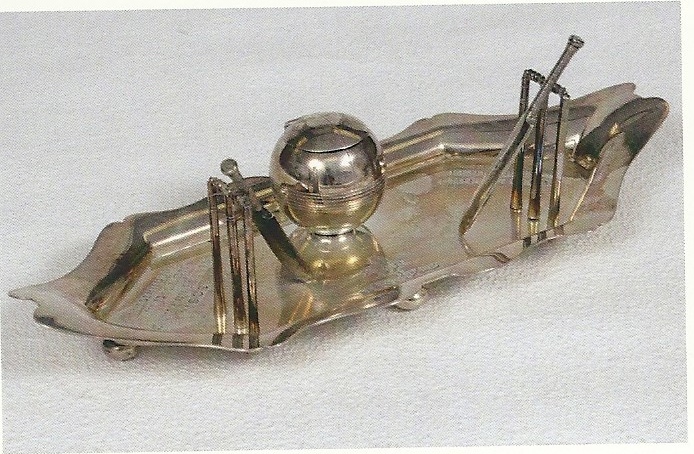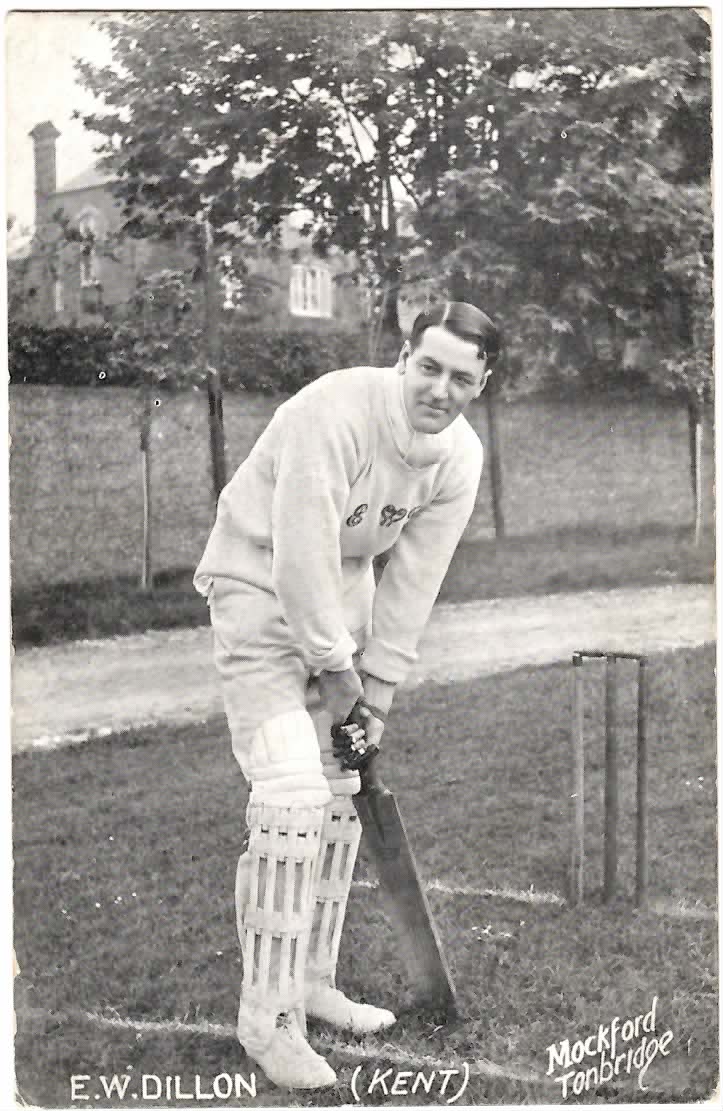We have acquired a new inkstand. It is not the sort of thing that Staples or W.H. Smith would have on their shelves – in fact, I doubt if any stationer these days stocks any kind of inkstand – but it is nevertheless one that we will cherish.

This little silver inkstand, no more than 6 centimetres high and 25 centimetres long by 10 centimetres wide, with cricket bats leaning on sets of stumps at each end and a cricket ball container for the ink, has probably never been used for its designated purpose, but it holds an important place in Kent cricket history. Made in 1909, it was presented at a banquet on 23rd October that year to Mr. E.W. Dillon. The inscription reads “Presented to E.W. Dillon. Champion Eleven 1909 by the Kent County Cricket Club.” Each of the players in the eleven that year received a similar inkstand, but this one is the cream of the crop. Edward “Ted” Dillon was the captain of the side that year, crowned county champions in his first season as leader. The triumph was celebrated all around the county, by all sorts of people including the Archbishop of Canterbury Randall Davidson, whose telegram to the team was read out at the banquet by the Mayor of Canterbury. “Please convey to your eminent guests an expression of very proud recognition of the county’s prowess.” We cannot tell from those few words whether he knew or cared more about cricket than his predecessor Archbishop Frederick Temple, who described cricket as “organised loafing”, especially as Archbishop Temple’s first cousin had been a first-class cricketer. All the same, it was a great season for Kent and the captain E.W. Dillon.
Kent had been champions three years earlier, in 1906, an occasion which inspired Lord Harris to commission the famous painting by Chevallier Tayler, “Kent v Lancashire 1906”, which now hangs at Lord’s. But the teams 1909 triumph was in a different league altogether. The county played 30 games that summer (26 in the championship) and lost only two. They won eighteen, ten of them by an innings. During the summer, Frank Woolley and Arthur Fielder put on 235 for the tenth wicket against Worcestershire at Stourbridge, setting a record which stands to this day, and which exceeded by just 5 runs the previous record tenth wicket stand, set in 1899 by the Middlesex pair of Nicholls and Roche, at Lord’s against Kent. 1909 was also the season in which 37 year old Douglas Carr made his debut for the county as a leg spinner. He did not come into the side until late July, but then took 61 wickets in eleven matches. Such was his immediate success that within two weeks of his Kent debut, he was picked to play for England against the visiting Australians. That was his only Test cap, and 1909 was his annus mirabilis, but without him, Kent might not have won the title.
Dillon, a left handed batsman and occasional leg break bowler, captained the side until the end of the 1913 season, and led the side to further titles in 1910 and 1913. He remains the only Kent captain to have won the championship more than once. He was an excellent all round sportsman, having played for Kent sporadically since the turn of the century, and finding enough time off from his shipbroking career to play four rugby internationals for England, as a centre, in 1904 an 1905. He never played for England at cricket, so could not claim to be a double international like his team-mate Wally Hardinge (football and cricket), but nevertheless was a fine example of the Edwardian beau ideal.

We have also recently acquired two elderly but well preserved county caps, one awarded to Frank Woolley and the other to Colin “Charlie” Blythe. We did not have caps of these two of Kent’s greatest ever players, so they will be an invaluable addition to the collection. 2017 marks the centenary of the death of Colin Blythe, the greatest left arm bowler in Kent’s history (with all due respect to Min Patel), and by Canterbury Week we will have completed the repair and re-inscription of the Blythe Memorial, and placed it in its new position, behind the Ames Stand close to the Nackington Road gate. We will keep you updated on progress.
We have also, incidentally, during the winter, had all the photographs of capped players which climb up the stairs in the Chiesman Pavilion restored and reframed with ultra-violet glass to protect them against future deterioration in the sunlight. We still have not quite solved the problem of finding further space for the photographs of county captains and the honours boards in the pavilion long room, but we will, we will.
We are also working hard on creating signs to commemorate the Kent cricketers after whom the buildings around the ground are named – Ames, Cowdrey, Woolley, Underwood and Knott. You will, we hope, see these in all their glory early in the season. They will be positioned on the outside of the buildings so that casual observers strolling around the ground can get some idea of who these great players were and what they did for the club. I suppose almost everybody knows all there is to know about Underwood and Knott, but even great players like England’s greatest all-rounder after W.G. Grace, or the only wicket-keeper to score one hundred hundreds, are beginning to fade in the memories of some – or indeed not even to have registered in the first place among some of our younger supporters.
Heritage is not just about the past. It is about putting the present and the future into context and showing the players and supporters of today and tomorrow how their current heroes fit into the rolling tapestry of Kent’s cricket history. We have had great players in recent years: Rob Key has scored more runs at Canterbury than any other player in history, and Matt Walker currently holds the record for the highest individual score by a Kent batsman at Canterbury, but we only know that because we remember the past. And by knowing these facts, we set targets for future players. That is the point of heritage.
We still have a great deal to do and not much money to do it with, so if anybody wants to join in and help us, we will welcome you with open arms. And it’s not just silver polishing that needs to be done.
Jonathan Rice jnhrice@googlemail.com
David Robertson david.robertson81@btinternet.com
0 Comments